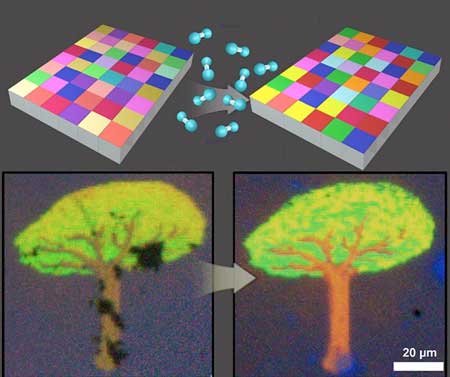| Sep 08, 2020 | |
Producing technicolor through brain-like electronic devices(Nanowerk News) Structural coloration is promised to be the display technology of the future as there is no fading - it does not use dyes - and enables low-power displays without strong external light source. However, the disadvantage of this technique is that once a device is made, it is impossible to change its properties so the reproducible colors remain fixed. |
|
| Recently, a POSTECH research team has successfully obtained vivid colors by using semiconductor chips - not dyes - made by mimicking the human brain structure (Photonics Research, "Structural color switching with a doped indium-gallium-zinc-oxide semiconductor"). | |
| POSTECH's joint research team consisting of Professor Junsuk Rho of the mechanical engineering and chemical engineering departments, Inki Kim, a mechanical engineering student in the MS/PhD integrated program, along with Professor Yoonyoung Jung and masters student Juyoung Yun of the Department of Electrical Engineering developed a technology that can freely change the structural colors using IGZO (Indium-Galium-Zinc-Oxide), a type of oxide semiconductor. | |
| IGZO is a material that is widely used not only in flexible displays but also in neuromorphic electronic devices. This is the first study that incorporates IGZO to nanoptics. | |
 |
|
| Diagram of IGZO-based variable color filter technology and the micro color pixel experiment results. (Image: POSTECH) | |
| IGZO can freely control the charge concentration within a layer through the hydrogen plasma treatment process, thereby controlling the refractive index in all ranges of visible light. In addition, nanoptical simulations and experiments have confirmed that the extinction coefficient of visible light is close to zero, thus enabling the actualization of a transmittable color filter in the penetrable form that can transmit exceptionally clear colors with extremely low light loss. | |
| The IGZO-based color filter technology developed by the research team consists of a 4-layer (Ag-IGZO-SiO2-Ag) multilayer and can transmit vivid colors using the Fabry-Perot resonance3 properties. Experiments have confirmed that as the charge concentration of IGZO layer increases, the refractive index decreases which can change the resonance properties of light that is selectively transmitted. | |
| This design method can be applied not only to color filters for large-scale displays, but also to color printing technique of micro (10-6, millionth) or nano (10-9, billionth) sizes. | |
| To verify this, the research team demonstrated a color printing technology that has a pixel size of one micrometer (µm, one millionth of a meter). | |
| The results proved that the colors from the centimeter or micrometer-sized color pixels can be adjusted freely depending on the charge concentration of the IGZO layer. It was also confirmed that the structural color can be changed more reliably and quickly through changing the refractive index via charge concentration compared to other conventional all solid-state variable materials like WO3 or GdOx. | |
| "This research is the very first application of IGZO to nanoptical structural color display technology. IGZO is the next-generation oxide semiconductor used in flexible displays and neuromorphic electronic devices," stated Professor Rho who led the research. He added, "It is anticipated that this technology, which enables filtering the transmitted light by adjusting the charge concentration, can be applied to the next-generation low-power reflective display and anti-tamper display technologies." |
| Source: Pohang University of Science & Technology (POSTECH) | |
|
Subscribe to a free copy of one of our daily Nanowerk Newsletter Email Digests with a compilation of all of the day's news. |
